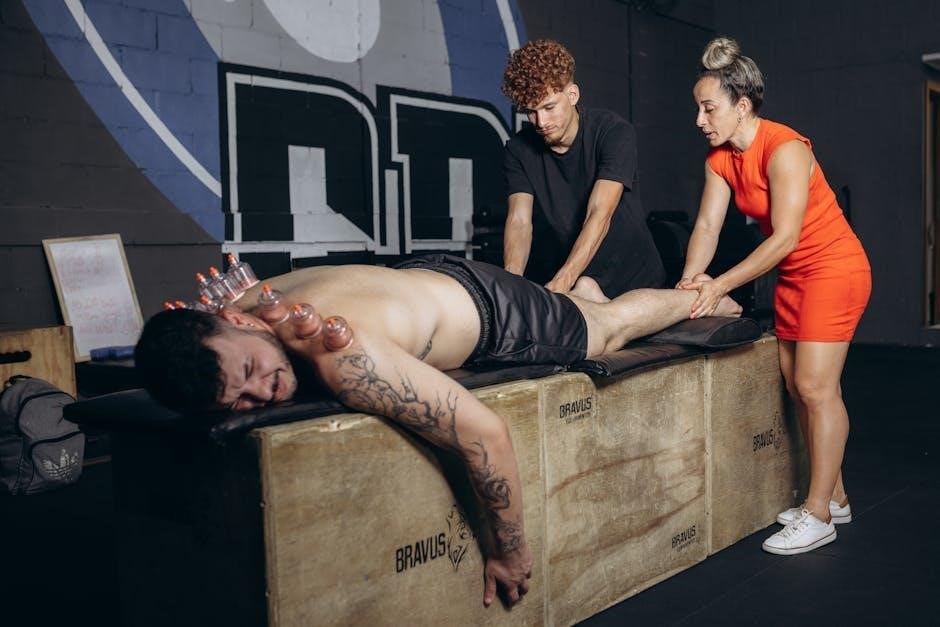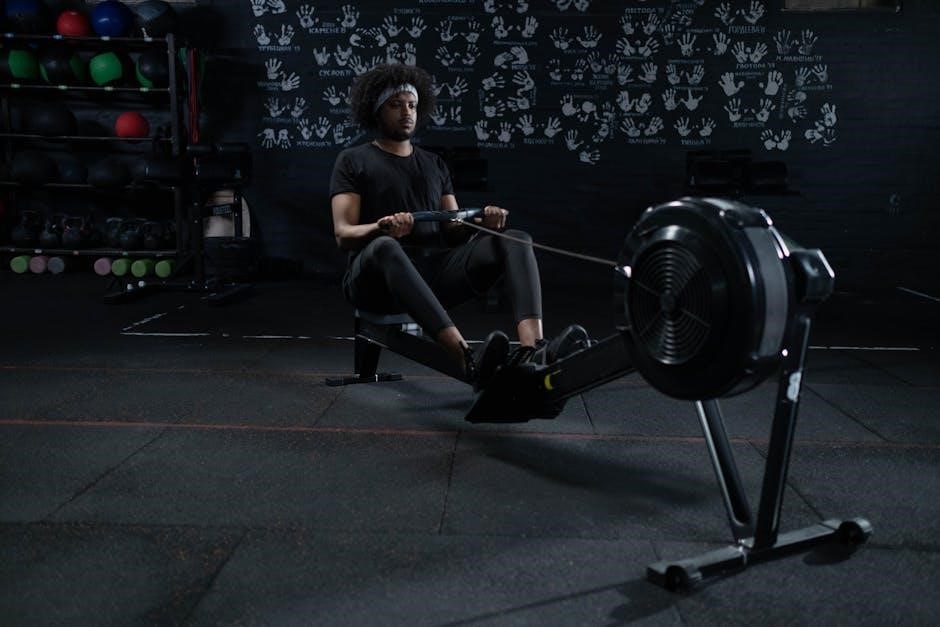Peroneal strengthening exercises are essential for improving ankle stability, preventing injuries, and enhancing overall lower limb function․ These exercises target the peroneus longus and brevis muscles, crucial for lateral ankle support and movement․ Regular strengthening routines, such as resistance band workouts and balance training, can significantly reduce the risk of peroneal tendonitis and chronic ankle instability․ Incorporating these exercises into your fitness regimen promotes long-term joint health and athletic performance․
1․1 Importance of Peroneal Muscles for Ankle Stability
The peroneal muscles, including the peroneus longus and brevis, play a critical role in providing lateral stability to the ankle joint․ These muscles are essential for preventing excessive inversion and eversion of the foot, which can lead to injuries such as ankle sprains or chronic instability․ Weakness in the peroneal muscles can result in poor ankle support, increasing the risk of tendonitis and other degenerative conditions․ Strengthening these muscles enhances balance, coordination, and overall lower limb function, making them vital for both athletic performance and daily activities․ By targeting the peroneals, individuals can significantly reduce the likelihood of ankle-related injuries and improve long-term joint health․
1․2 Brief Overview of Peroneal Tendonitis and Its Relation to Weakness
Peroneal tendonitis is an inflammatory condition affecting the tendons surrounding the peroneal muscles, often caused by overuse, direct trauma, or repetitive stress․ Weakness in the peroneal muscles can contribute to this condition, as the tendons bear increased strain to compensate for poor muscle support․ Symptoms include pain along the outer ankle, swelling, and limited mobility․ If left untreated, tendonitis can progress to chronic instability or degenerative changes․ Strengthening the peroneal muscles is crucial in rehabilitation, as it reduces tendon strain, enhances joint stability, and prevents recurrence․ Addressing muscle weakness early on is vital to avoid prolonged recovery and restore full functional mobility․

Understanding Peroneal Tendonitis and Its Symptoms
Peroneal tendonitis is inflammation of the peroneal tendons, causing pain, swelling, and limited ankle mobility․ Early identification of symptoms is crucial for effective treatment and recovery․
2․1 Common Causes and Risk Factors
Peroneal tendonitis often arises from repetitive stress or overuse, particularly in activities involving excessive ankle rolling or inversion․ Risk factors include poor footwear, uneven surfaces, and sudden increases in physical activity․ Anatomical issues, such as high arches or tight calf muscles, can also predispose individuals to this condition․ Additionally, weak peroneal muscles or imbalances in lower limb strength may contribute to tendon strain․ Overweight individuals and those with a history of ankle injuries are at higher risk․ Addressing these factors through targeted exercises and proper footwear can help prevent peroneal tendonitis and promote overall ankle health․
2․2 Signs and Symptoms to Watch For
Pain on the outside of the ankle is a common symptom of peroneal tendonitis, often worsening with activity․ Swelling, warmth, and tenderness along the lateral ankle may also occur․ Patients might experience stiffness, particularly after periods of rest, and pain when pressing on the affected area․ Activities involving ankle inversion or dorsiflexion, such as running or sudden changes in direction, can exacerbate symptoms․ In severe cases, a snapping or popping sensation may indicate a tendon rupture․ If left untreated, chronic instability and limited range of motion can develop․ Early recognition of these signs is crucial for effective treatment and prevention of further complications․

Resistance Therapy for Peroneal Strengthening
Resistance therapy effectively strengthens the peroneal muscles through controlled exercises like eversion and heel raises, improving ankle stability and reducing injury risk․
3․1 Using Therapy Bands for Effective Resistance
Therapy bands are a versatile and effective tool for peroneal strengthening․ They provide controlled resistance, allowing for targeted muscle engagement without heavy equipment․ To use a therapy band, loop it around the ball of your foot while sitting with your legs straight․ Slowly evert your foot against the band’s resistance, then return to the starting position․ Repeat for 3 sets of 15-20 repetitions; This exercise strengthens the peroneus longus and brevis muscles, improving ankle stability and reducing the risk of tendonitis․ The adjustable tension of therapy bands makes them ideal for progressive resistance, ensuring continuous muscle growth and strength․ Regular use can enhance flexibility and overall lower limb function, making them a cornerstone of peroneal rehabilitation programs․
3․2 Eversion Exercises to Target Peroneus Longus
Eversion exercises are a cornerstone of peroneal strengthening, specifically targeting the peroneus longus muscle․ To perform an eversion exercise, sit with your legs extended and loop a therapy band or towel around the ball of your foot․ Anchor the other end to a stable object․ Slowly move your foot outward against the resistance, holding for 5 seconds before returning to the starting position․ Aim for 3 sets of 15-20 repetitions․ This exercise enhances lateral ankle stability, reduces the risk of peroneal tendonitis, and improves overall lower limb strength․ Eversion exercises are highly effective for both rehabilitation and preventive care, making them a key component of any peroneal strengthening program․

Ankle Stability and Balance Exercises
Ankle stability and balance exercises are crucial for peroneal strength․ Use a wobble board or BOSU ball to enhance proprioception and prevent injuries․ Heel raises also improve balance․
4․1 Wobble Board Exercises for Improved Balance
Wobble board exercises are a highly effective way to enhance balance and ankle stability, crucial for peroneal strength․ Start by standing on the wobble board with feet shoulder-width apart, holding onto a chair for support if needed․ Slowly rock the board forward and backward for 30 repetitions, then side to side for another 30․ As balance improves, progress to rotating the board in a circular motion, ensuring the edge remains in contact with the floor․ These movements strengthen the peroneal muscles and improve proprioception, reducing the risk of ankle injuries․ Over time, reduce support and aim to stand unassisted for up to 2 minutes․ Regular practice enhances overall ankle stability and functional mobility․
- Start with support and gradually reduce as balance improves․
- Aim for 30 repetitions in each direction․
- Progress to unassisted standing for optimal benefits․
4․2 Heel Raises as a Strengthening and Stretching Tool
Heel raises are a versatile exercise that combines strengthening and stretching benefits for the peroneal muscles and tendons․ To perform, stand with feet shoulder-width apart, holding onto a sturdy object for balance․ Slowly raise your heels off the ground, lifting your body onto your toes, then lower back down․ This movement targets the peroneus longus and brevis muscles, enhancing their strength and flexibility․ Regular heel raises can improve ankle stability and reduce the risk of peroneal tendonitis․ For added challenge, progress to single-leg heel raises or incorporate resistance bands․ Consistency is key to achieving optimal results and promoting long-term ankle health․
- Perform with or without support based on balance confidence․
- Progress to single-leg variations for advanced strength․
- Incorporate resistance bands for increased intensity․

Range of Motion and Stretching Exercises
Range of motion and stretching exercises are vital for maintaining ankle flexibility and preventing stiffness․ Plantarflexion and dorsiflexion movements improve joint mobility and reduce injury risk․
- Perform slow, controlled movements for optimal benefits․
- Incorporate dynamic stretches to enhance recovery․
- Aim for 3 sets of 15-20 repetitions daily․
5․1 Plantarflexion and Dorsiflexion Exercises
Plantarflexion and dorsiflexion exercises are fundamental for improving ankle mobility and reducing stiffness․ These movements target the peroneal muscles and Achilles tendon, enhancing flexibility and strength․
- Sit or stand with feet flat, then point toes away (plantarflexion) and pull back toward the shin (dorsiflexion)․
- Use a resistance band or towel for added tension during the exercises․
- Hold each stretch for 15-30 seconds and repeat 3 times daily․
These exercises are essential for maintaining proper ankle function and preventing injuries․
5․2 Dynamic Stretches to Enhance Recovery
Dynamic stretches are essential for enhancing recovery by improving blood flow and reducing muscle tension․ These exercises involve controlled movements that prepare the muscles for activity and aid in post-workout recovery․
- Ankle circles: Rotate the ankle in both clockwise and counterclockwise directions to improve flexibility and reduce stiffness․
- Calf raises: Perform dynamic calf raises to stretch the Achilles tendon and peroneal muscles․
- Leg swings: Swing one leg forward and backward, then side to side, to enhance circulation and mobility․
Dynamic stretches promote faster recovery by preventing scar tissue formation and maintaining optimal muscle function;


